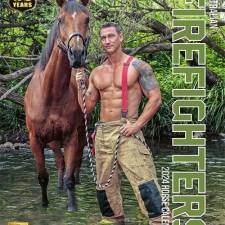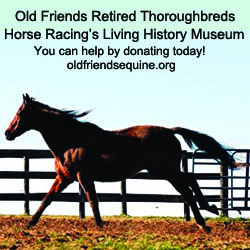
by Donna Brothers
(I owe a debt of gratitude to Dr. Larry Bramlage and Euki Binns for their help in validating research and statistical information for this article, and to @JennyPhoto for the supporting pictures.)
I can no longer remain silent about my love for horses and for horse racing for fear of backlash from PETA and other extremist organizations that claim to be looking out for our horses’ welfare. PETA’s modus operandi is to scream louder than the people and industries they attack, but unfortunately, while they promote themselves as a savior of horses, a closer look into their practices suggests otherwise. I have read through numerous lawsuits against them, I’ve looked up their kill-rates, and I’ve read about their revenue allocations. PETA is pro-PETA, not pro-animals, and they are behaving like a bully.
PETA vs the horse-lover
In PETA’s Statement on Companion Animals, they state their belief that even dogs and cats (domesticated for thousands of years alongside our horses) should be free of all human interaction. In other words, PETA is on a mission whose end-game is to eventually halt the natural bond between man and animal that has led them to co-exist since before written record! Organized horse racing has been a part of our United States family culture since at least 1667. Long before the invention of baseball, basketball, football—pretty much any current sport you can think of— people were enjoying a variety of equestrian sports with their beloved horses. Horses have also seen man into civilization; helped them win battles at war; carried man across continents; plowed their fields (including the grain, hay and bedding these horses needed to survive through hard winters), led hunts and so much more for thousands of years. Yes, horses have taken care of man—but man has taken care of them too.
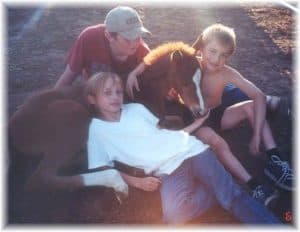
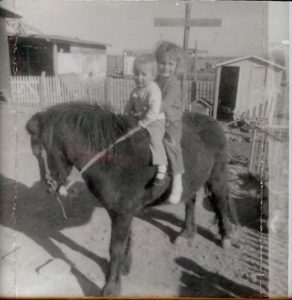
People haven’t domesticated horses, dogs and cats, they’ve domesticated themselves. At some point along the evolutionary chain these once wild animals realized that living near and around homo sapiens could benefit them. As they got closer and closer to our bi-pedal species their food sources became more reliable and their living conditions became less volatile. And so these relationships have grown over the years and we’ve become closer to our animals and them to us. And now, after thousands of years of evolutionary development of these mutually beneficial interactions, PETA marches in insisting that this is all wrong? Well I beg to differ.
I have been involved with and loved horses since my earliest memories. My mother rode horses with me in her womb and I have no memory of when I rode my first horse: I’ve just always ridden. I don’t just love horses, I live and breathe them and owe everything I have to them. In fact, I’ve been taking care of horses—and they’ve been taking care of me—for my entire life. I do not and will not apologize for my love of the horse or of horse racing.
Feral horses vs domesticated horses
The thing about horses is that they’re going to run, play, jump, frolic and race across vast fields with or without us. What makes us love them is that they are gracious enough to let us go along for the ride. And, yes, sometimes horses are fatally injured alone in a field—or on the track—while doing this. It will break my heart every single time, but I know with all that I am, that they love their humans and their sport as much as we love them and this sport that allows us to interact with them in a deeply meaningful and fulfilling way.
Injury and other causes of death
The causes of death for a horse are many. Colic is the number one cause of death in domestic horses though infectious diseases, metabolic diseases, bone and tissue degeneration, and acute trauma (including fractures) also ranks high. But, in terms of evolution, fracture injury is the natural mechanism by which most horses’ lives terminate, and our studies of feral and other wild horses show that this remains the number one reason for elimination of wild horses from the herd.
Though musculoskeletal injury to a horse during racing is an aberration, it is a gut wrenching event for everyone. Horses are made to run. Horses love to run. But history shows us that running naturally ends the majority of horses’ lives when left to their own devices. In fact, humans don’t force horses into vulnerability, it is just the opposite. Much of what humans know about the care of horses, from our advances in modern medicine, our understanding of biomechanics and training, and our advances in nutrition and therapeutic protocols, is owed to private funding from the thoroughbred racing industry. We reduce the likelihood of terminal skeletal injury, and we’re getting better at it all the time. That said, we cannot totally eliminate the evolutionary destiny of horses left to their own accord anymore than we can eradicate all diseases and fractures in man.
PETA behind the scenes
As for PETA. Please. All one has to do is Google “people against PETA” to find website after website, article after article of the atrocities that PETA has committed upon domesticated animals and the families that own them. Yes, if they have their way we will never race horses again, nor will we be able to ride them in any fashion. No show jumping, no dressage, no hunters, no endurance, no pleasure and no trail riding…all of it banned, eventually. To PETA, this isn’t about racing.
PETA is against people interacting with animals. Sound extreme? I didn’t make this up; it’s in their Statement on Companion Animals! PETA believes that harboring a domesticated animal of any kind (most of which are unable to survive in the wild) is a cruel form of animal slavery. This is extreme, and yet PETA takes it one step further: PETA believes that domesticated animals are better, not simply set free, but euthanized straight away in the event that they contract an infectious disease or get hit by a moving vehicle. Illness or injury is not PETA’s only standard for euthanasia. Dozens of articles can be found online of PETA’s active mission to not just euthanize the sick and injured, but perfectly healthy dogs, cats, kittens and puppies. This calls into question their ability to follow not only their own publicized standards for euthanasia, but the legal standards they must follow to continue operating their shelter in Virginia.
Nathan J. Winogard, graduate of Stanford Law School, animal rights consultant and executive director of the national No Kill Advocacy Center estimates here, that PETA’s effective kill rate for cats in 2018 came in at 99% when taking into account the agreements they have with shelters to euthanize the animals PETA delivers to them.
According to this 2015 article from the Washington Post, PETA’s kill rate for 2014 was 81%, with a kill rate in some years exceeding 90%. By comparison, that same article states that the average kill rate at other Virginia shelters came in at less than 25%.
In the linked article by Adele Douglass, the Executive Director of the nonprofit, Humane Farm Animal Care states that following an official investigation to determine if PETA’s shelter license could be revoked in the state of Virginia, Dr. Daniel Kovich, an investigator for Virginia Department of Agriculture issued the following: “The findings of this site visit support the assertion that PETA does not operate a facility that meets the statutory definition of an animal shelter as the primary purpose is not to find permanent adoptive homes for animals.” PETA’s lawyer responded to VDACS arguing that a legal technicality protected their status as an animal shelter.”
In an article by Julie Scheidegger for DVM Magazine, she offers this compelling quote from AKC Chairman, Alan Kalter, “While most shelters strive for a 90% re-homing rate, PETA is apparently proud of their 99% killing rate and callously boasts that the animals it rescues are ‘better off dead.’ That is an alarming ratio that should be fully investigated. PETA’s track record is absolutely unacceptable,”
“I would go to work early, before anyone got there, and I would just kill the animals myself…I must have killed a thousand of them, sometimes dozens every day.” Ingrid Newkirk, founder and president of PETA,
This is a quote by Newkirk from a 2003 interview with Michael Specter, for The New Yorker. In this same article, Newkirk shuns even the use of guide dogs and had admitted to taking a seeing-eye dog away from the dog’s blind owner.
Do you want an organization such as this, protecting your beloved companions?
I understand the knee jerk reaction when a horse suffers a catastrophic injury – when ANY living being suffers a catastrophic injury. When something so heartbreaking happens, I often think this hurts too much to bear. It sounds silly to those who don’t follow horse racing, but these horses aren’t just our friends. We work with them day in and day out. Our entire life revolves around their care and they become family. We cheer for them and fear for them. We hope for them, we laugh with them, and we even cry for them. The loss of even one of our horses can make me wonder if the angry voices are right.
PETA: a reality check
And that’s when I have to take a deep breath, leave emotion and impetuous judgements behind, spurn Pollyannaish aspirations, and come back to reality. Statistics can be difficult to ignore whether they support your cause or impugn it. Compared to approximately 55 training or racing fatalities per month in the U.S. (1.86 per 1,000 starts), there are nearly 3,300 human deaths per month due to automobile accidents.
With these approximately 55 horse fatalities spread throughout all U.S. tracks, it is truly a rare occurrence to witness one. It is also rare to actually see a dead person on the side of the road, and yet a person is 60 times more likely to die when they get in a car than a racehorse is to die when exercising. Witnessing even one catastrophic vehicular accident can scar a person for life, and yet we continue to make the decision to buckle our children into car seats or seat belts on a daily basis.
Responsible media reporting
It turns out that it is actually safer to race our horses than it is to drive our children on the roads, but if we leave the story-telling of this subject to extremist groups such as PETA and sensationalist media sources seeking to exploit anyone’s suffering, anyone’s loss, any negative tidbit that can be found in order to increase their ratings, views, clicks and hits, then those who know very little about horse racing would be led to believe the loudest voice: extremist organizations like PETA and known, sensationalist news outlets that in the end, are also deeply profiting from this gambit.
Irresponsible media reporting is not the fault of the public. They’re simply watching news they have been told they can trust, and then reacting instinctively. Any psychologist will also tell you that we humans are emotional creatures that are prone to category errors and dreadfully poor at understanding and calculating risk. As an example, consider all of the people you know who are deathly afraid of spiders and/or snakes in spite of the fact that, in the United States, you have about a one in 50 million chance of dying from a snake bite. And since the dawn of modern anti-venom, death from spider is almost nonexistent. Even in Australia, a place known to have some of the most venomous spiders in the world, there have been no reported deaths related to spider bites since 1979.
Like all sport horses (from warmbloods to Arabians and beyond), our Thoroughbred racehorses are athletes. Just like human athletes, our equine athletes suffer injury in both competition and training. Many of these injuries are repairable given sufficient time off, however, broken bones are often catastrophic and fatal because horses do not understand that they need to keep weight off of a leg in order for it to heal and they are biologically designed to stand and graze. In some (though not all) cases, the humane option is euthanasia. In the wild, a broken bone ensures the horse suffers until being found and eaten by a predator.
I’ve seen numerous competition, training and pasture accidents (including breaks) in our other competitive equestrian sports as well. The two major differences are that one, every competition isn’t captured on camera as it is in organized horse racing and, two, there is not as much money involved with many of these other disciplines and so the visibility and reporting also isn’t there.
The use of force
One of the arguments against racing that I’ve heard is that people can accept injuries in human athletes since they choose to compete, but race horses are forced to race—it’s not their choice. Any horseman reading this can confirm that this is not even possible!
I once was told a story about a very reluctant horse tasked to a European cavalry officer from World War II that had had the opportunity to ride/train many horses and was himself a former Olympic team member. This had been the most difficult case he had ever had and it was with a beautiful warmblood with tremendous ability that would not move forward once tacked. He and multiple other trainers at the royal academy had attempted to resolve this problem but without success, even though these were some of the most elite riders in the world (and yes, non-injurious force was attempted)! Do you know who won? The horse, and it was turned out to pasture. A rare but telling example of just how strong (and strong-minded!) these beautiful animals that we call both friend and companion are.
If a horse does not want to race there is no amount of persuasion that will change that horse’s mind. I’ve seen horses that don’t want to race—and we don’t race them! Not every thoroughbred is born with racing on their mind but the vast majority of them are, just like not every horse bred to be an eventer, wants to event, and likewise with dressage and every other discipline in which a team effort must occur. Our horses that race, love to race, and we love to watch them—even help them—achieve their best form.
A good task for PETA
Look, if PETA really wants to clean up their act and become the self-professed savior of animals that they call themselves, they should start with putting their efforts toward banning puppy mills. Right now, with regard to dogs, the majority of PETA’s efforts are going toward simply euthanizing every stray dog that comes into one of their so called “shelters”, including well-loved (but lost) family pets being euthanized within hours of intake and without being allowed a waiting period for their owners to find them.
According to the Humane Society’s website there are upwards of 10,000 puppy mills churning out dogs every day—many of which will either never see the light of day or will eventually end up on the street, in a shelter, and then eventually euthanized by organizations like PETA.
In fact, the Humane Society states that more than 194,000 dogs “are kept solely for breeding in USDA-licensed facilities. Sadly, a license is not a guarantee of a breeder’s quality.” Nor is buying from a licensed facility any kind of a guarantee about a dog’s life. Some of their “breeding stock” never see the light of day and are kept in tiny and filthy pens and crates. Inbreeding is rampant and deformities and other life limiting and life threatening illnesses abound due to extreme neglect. And yet, two million puppies are sold each year from these puppy mills.
I have dogs—two of them. Both are rescues and one came from the Humane Society. I couldn’t imagine buying a “designer dog” when there are so many wonderful dogs in need of a good home and, yet; PETA wants to pick on us? Why is that? Perhaps because that’s where the money is and PETA likes their bottom line. It’s nasty business going into a puppy mill. Have you ever seen one? Google it.
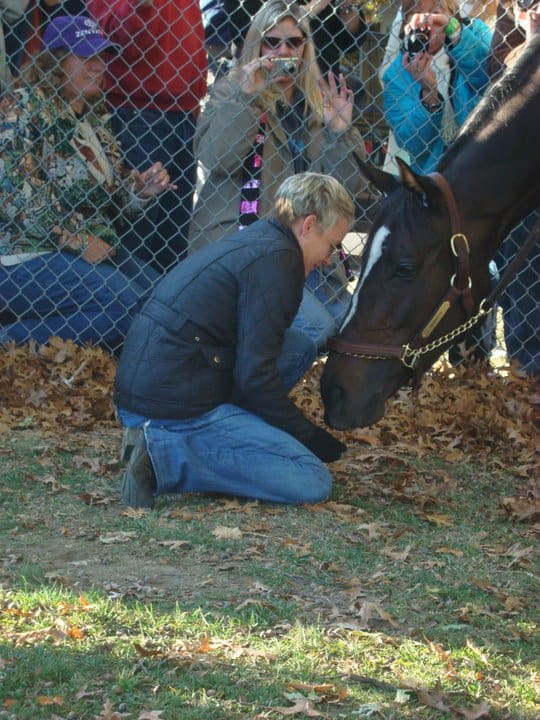
Statistics on PETA, self professed “savior” of animals
Using public records gathered from the Virginia Department of Agriculture and Consumer Services, over the last 21 years, PETA’s kill rate comes in at an astounding average of 85%. PETA’s average rate of adoption over the last 21 years tallies in at 7%. According to numerous reports I’ve read on this, including this affidavit from a former PETA employee that states animals were routinely euthanized in a PETA van before they even arrived back at the shelter, most of PETA’s intakes are not at the shelter for more than 24-48 hours before being euthanized.
According to the Center for Organized Research and Education (CORE), an organization that tracks nonprofit activities: “Over a ten year period, PETA spent four times as much on criminals and their legal defense than it has on shelters, spay-neuter programs, and other efforts that actually help animals.” PETA’s direct involvement and financial support of criminal organizations such as SHAC, ALF and ELF is not a secret – these are organizations that the FBI conservatively estimates (according to the article) as having caused more than $43 million in damages with a list that includes breaking into the private homes of (and assaulting) scientists, planting car bombs, cutting brake lines of food delivery trucks, planting fire bombs in restaurants, razing university labs, and the list goes on.
My stomach churns with writing this, and the deeper I dug into my investigation, the more insanity I uncovered. PETA doesn’t “do” constructive discussion, and they certainly don’t “do” reform. Until all animals are “liberated” from humans, the trail of death and destruction they leave behind wont abate—even when that liberation means “freedom” via a twisted definition of euthanasia that PETA delivers even to perfectly healthy and happy animals.
But it doesn’t end there. As I read through endless lawsuits (those initiated by PETA and those brought against PETA), the media surrounding one in particular stood out. PETA went so far as to sue Whole Foods (a national natural foods market) for charging more money for meats that were raised the most humanely vs. those that were simply antibiotic-free and hormone-free. Here’s an article from the Humane Society’s blog defending Whole Foods.
Quite frankly, I’m vegetarian but I’m not an extremist. I don’t expect everyone to stop eating meat just because I did five years ago. I shop at Whole Foods, and consider them to fall into a class of non-government organizations (NGOs) that are actively having those tough conversations, and trying new things like their food certifications and their donations to food banks on both a global and local level. These are the types of activities that lead to community-wide change, conservation, humane treatment efforts, and education, and they’re not alone. They’re one of the leaders in this charge by being the change they wish to see.
PETA should be dealt with in the way that bullies are best disempowered—and no, not by ignoring them! PETA is the type of bully that will not simply go away. The only way to nullify their influence is to be a brighter light, a better influence. To spread the word about how we do love our horses and we do care for them.
My call to action – please help racing. We are custodians of the Thoroughbred racehorse!
Sharing stories and photos of newborn foals; yearlings playing in a field; a groom and/or exercise rider lying in the stall with their beloved race horse; off-track Thoroughbreds in a new discipline; a jockey hugging a horse around his neck as they are entering the winner’s circle…across the country, every single one of us who is a horseman, a horse lover and an advocate for the horse, has photos and stories to tell of how important horses are to them, and how important they are to their horse’s lives as well!
Please post images on Facebook, Twitter, Instagram, any of your blogs and other social media outlets of your choice! Show us when you were a child and riding your first horse—or your favorite horse! Sharing stories about how you fell in love with horses and horse racing! If you need ideas, please go to “Juanita Webb” on Facebook (she’ll be the Juanita Webb pictured with a horse—of course) and read her post from Oct. 11, 2019. Or, visit “We Are Horse Racing” on Facebook to see lots of stories, each with a photo, about how people fell in love with horse racing. Susie Raisher’s (Daily Racing Form) photo at below is a beautiful example.
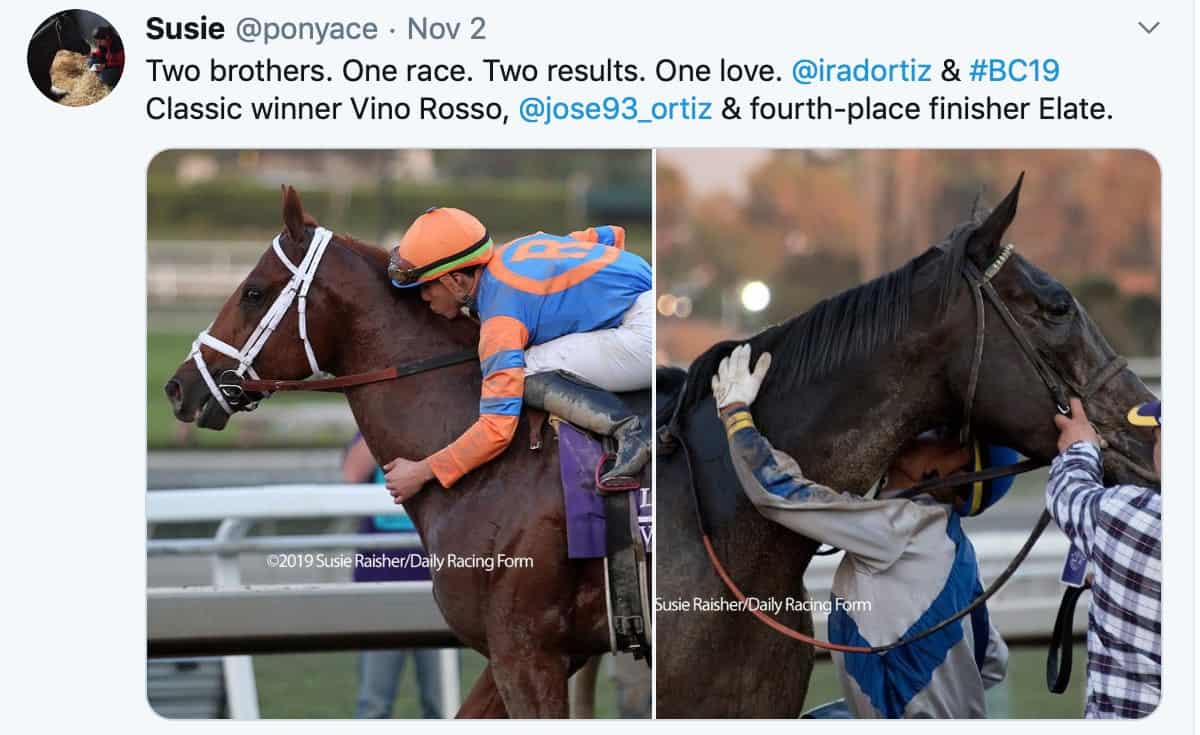
This is not a time to stand silently and idly by while we watch a bully on their pulpit: the compliant, cynical and fatalistic media and the extremist groups that help them line their pockets. In many cases the media outlets are simply uninformed and, yes, this is to some extent their own fault. However, PETA is handing them a story to tell. What sort of stories are we offering? This is the time to wear your heart on your sleeve. It’s long been respected on the racetrack to keep your emotions in check and stay mum about the people, horses, dogs, and cats that mean the most to you. This is not the time for stoicism—but rather, for activism. Are you with me?
Post Script: I would like to clarify that I am NOT opposed to reputable dog breeders or dog breeding. Our late but beloved Jack Russell Terrier came from a small and reputable dog breeder. These breeders love their dogs as much as we do our horses. Puppy mills are another entity all together and comparing reputable breeders to puppy mill owners is not something I would ever do. Puppy mills hurt the work that reputable breeders actively engage in to preserve and improve the health and disposition of their breeds. I’m sorry to anyone that I offended who is in the business of loving and producing wonderfully bred dogs. I stand WITH you, not against you.
Sincerely,
Donna Brothers

Donna is one of the most decorated female jockeys of all time. Now retired from race-riding, she is currently an award winning sports analyst and commentator for NBC, and the author of the book, “Inside Track: Insider’s Guide to Horse Racing”, which is now in its second printing. When she’s not on location, or in meetings, you can find her writing, reading, traveling and spending time with her husband Frank and her two dogs. Subscribe now to get new posts from Donna delivered to your inbox.
This article originally appeared on Donna Brothers and is published here with permission.
Read more informative articles in our section on Retire & Rehome.








